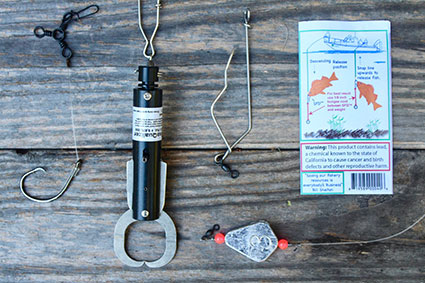July 2, 2020

Descending devices (two varieties of which are shown at center) will soon become a required part of snapper-grouper anglers' tackle boxes. (Photo: E. Weeks/SCDNR)
To encourage best fishing practices and improve fish survival, NOAA Fisheries recently announced new gear requirements that will apply to offshore anglers from North Carolina through the Florida East Coast. Beginning July 15, 2020, anglers targeting snapper or grouper species will be required to have a descending device on board and readily available for use. Additionally, the new rule “requires the use of non-offset, non-stainless steel circle hooks when fishing for snapper-grouper species with hook-and-line gear and natural baits” in South Carolina coastal waters.
Over fifty fish species fall under the umbrella of the snapper-grouper ‘complex,’ a diverse collection of large offshore fish that are sought-after table fare and critical to a healthy ocean ecosystem. In South Carolina, some of the most commonly encountered snapper-grouper species are black seabass, vermilion snapper, triggerfish, red snapper, gag grouper and spadefish.
Many snapper-grouper species live a long time, grow slowly, and reach maturity at a late age – all of which makes them vulnerable to overfishing and makes each adult fish valuable to the overall population.
Because these fish are often pulled from deep waters, they’re at high risk of barotrauma, a potentially fatal condition that occurs when fish undergo rapid pressure changes. Barotrauma, often accompanied by bulging eyes and bloated stomachs, can be a death sentence for caught-and-released fish.
Fortunately, barotrauma can be reversed through the use of a simple tool called a descending device, which helps anglers return a fish to the deeper waters from which it was caught. Descending devices can range from sophisticated, commercially available instruments to a DIY weighted hook.
Since 2017, SCDNR has partnered with the FishSmart program to distribute hundreds of descending devices to South Carolina residents. These devices are a safe and effective way to ensure that deepwater fish have a greater chance of surviving catch and release, benefiting both the angler and the fishery. For more information on descending devices.
A limited number of these devices are still available for South Carolina residents that are willing to participate in the FishSmart program by providing a valid email address and answering a follow-up survey. Please email SCDNR saltwater fishing coordinator Matt Perkinson at PerkinsonM@dnr.sc.gov for more details.
For more information about these changes, please read NOAA Fisheries’ full bulletin.
Additional details regarding best fishing practices and descending device requirements are available here.



